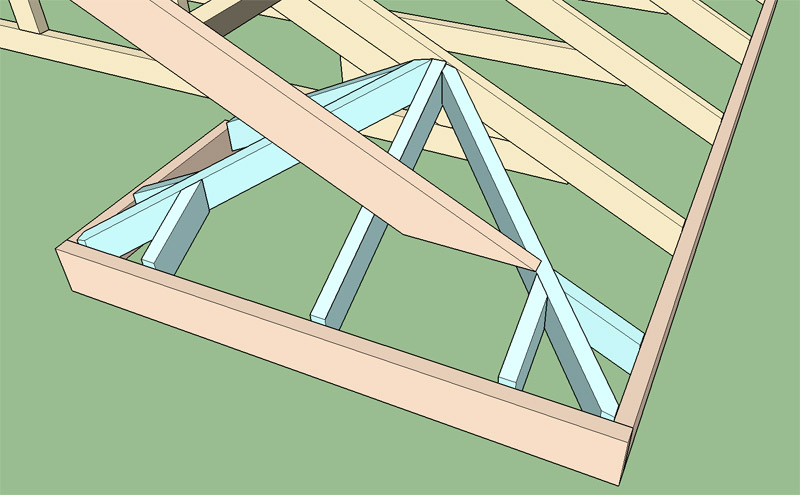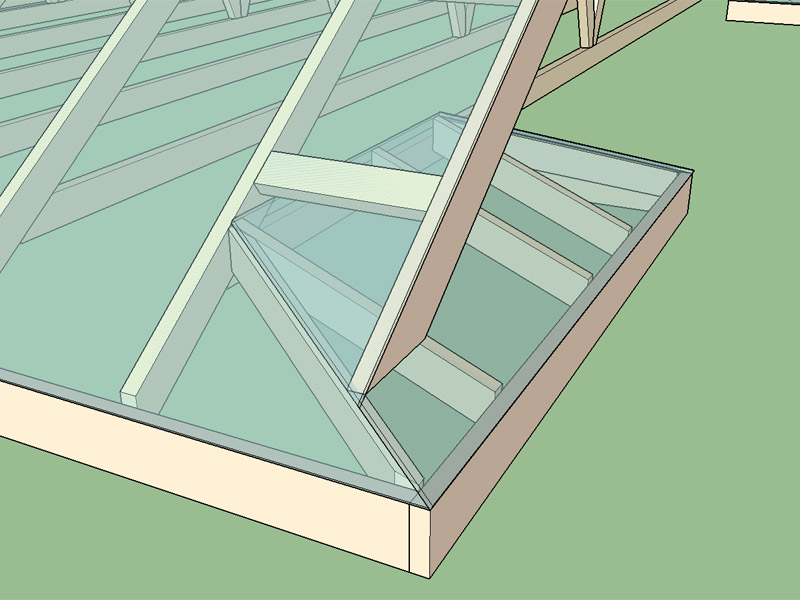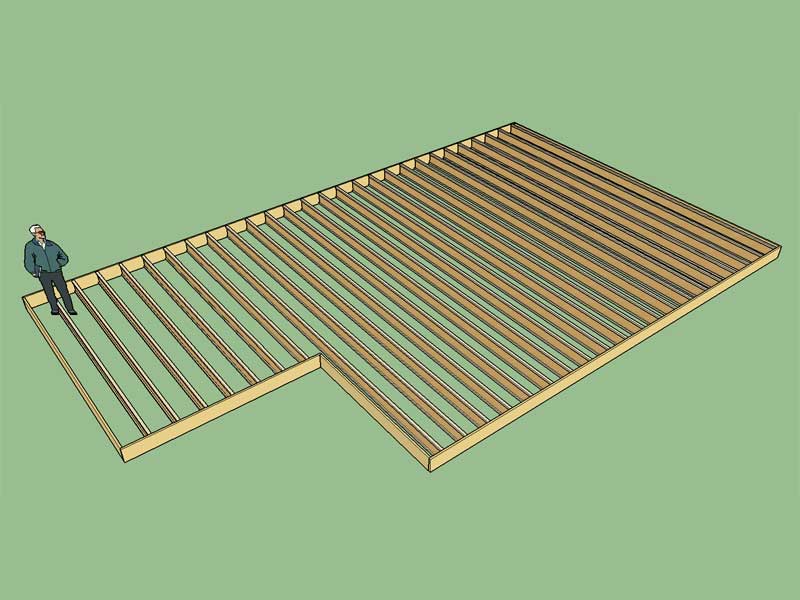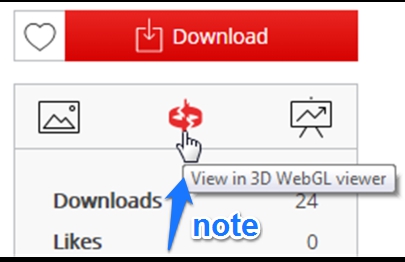3D Truss Models
-
This is an excellent link:
They run the outside hip rafter back to the gable wall and don't run the barge rafter (rake board) to the fascia like I've shown, maybe I've got this wrong...
This method would allow for sheathing of the return without having to notch around the barge rafter. I call this the floating barge rafter method:

Compare with extending the barge rafter all the way to the fascia board:

-
Version 1.6.4 - 06.27.2016
- Added roof return option within the advanced options menu for common, scissor and vaulted trusses, configurations: (HIP).

View model here:
3D Warehouse
3D Warehouse is a website of searchable, pre-made 3D models that works seamlessly with SketchUp.
(3dwarehouse.sketchup.com)
https://www.kubity.com/p/DnsBmT
This option is available for most typical triangular shaped trusses.
I will be adding the gable and full return at a later date, currently only the hip return is available. Another limitation is that the return roof pitches currently default to the main roof pitch. I need to add some additional code that will allow the pitch of the return portions to be set independent of the main roof pitch.
-
12:12 main roof with a 8:12 hip roof return. The interesting part is the hip rafter
where the return meets the main roof plane. The dropped hip rafter is off center so that it supports the sheathing from both planes. The calculations might prove challenging.
Typically the return pitch is less than or equal to the main roof pitch. In fact I don't think I've ever seen a return with a pitch greater than the main roof.
-
Roof return pitch can now be set independent of main roof pitch:

The calculations for a hip rafter that handles two pitches was insane as expected. I've also made some other minor adjustments and bug fixes related to the sheathing and rake board when the roof return extension equals the gable overhang.
I've set it up so that the return pitch can also be greater than the main roof pitch but its doubtful if this will find any usage.
There may be better ways of framing the hip rafter where the return meets the main roof, any thoughts on this are welcome. The initial release of 1.6.4 had a bug with attic trusses and the returns so I suggest downloading the latest version.
I'm also looking for photos of the framing for a full greek return to further study this.
-
Looking at the lumber and I-Joist floor module this morning and thinking it might be nice to make an option that allows one to specify something other than a rectangle for the floor outline. For example an L-shaped floor outline:

View model here:
3D Warehouse
3D Warehouse is a website of searchable, pre-made 3D models that works seamlessly with SketchUp.
(3dwarehouse.sketchup.com)
Or even more exotic shapes with non-orthogonal corners. I'll be giving this some thought over the weekend.
-
Hi Nathaniel,
Will you be able to include an option to generate purlins / battens? Here our standard construction method places this in the position where the roof sheathing goes, directly on top of the trusses. The top and bottom batten / purlin position could possibly be customisable (distance from apex and from edge / fascia). Obviously will require input field for width / height, maximum spacing field as well but this should possibly require a toggle for constant spacing from lowest portion of TC to apex position.
I would really appreciate this, unless the function is there and I'm missing it, please advise... Thanks in advance!
PS:
I know the focus of the plugin is for the roof trusses / structure, but could you have an option to include the roofing material? This only needs to be a simple structure, similar to the sheathing option but placement on top of purlins / battens with input field for thickness.
-
I forgot to add, the UI version seems to need a little TLC, see attached image.
Probably one of the following:- window sizing to be increased
- icon sizing to be decreased
- resizable window
- scroll-bars

-
I just downloaded your plugin to try it out...
Although my need for something like this is very limited, it's excellent!

Like Juju, I'm also having an issue with the window size, so I assume that it's something you'll take care of in an upcoming release...
-
I just re-installed the plugin into SU 2016 to further check into the html window size issue. The funny thing is that the window size appears to open to the same size for all my html UI pages regardless of the size I specify. Is this a bug with SketchUp or the API or is this something I'm doing wrong, the issue is with the WebDialog.new command where I specify the width and height of the webdialog. I need to look into this further.
-
@juju said:
Hi Nathaniel,
Will you be able to include an option to generate purlins / battens? Here our standard construction method places this in the position where the roof sheathing goes, directly on top of the trusses. The top and bottom batten / purlin position could possibly be customisable (distance from apex and from edge / fascia). Obviously will require input field for width / height, maximum spacing field as well but this should possibly require a toggle for constant spacing from lowest portion of TC to apex position.
I would really appreciate this, unless the function is there and I'm missing it, please advise... Thanks in advance!
PS:
I know the focus of the plugin is for the roof trusses / structure, but could you have an option to include the roofing material? This only needs to be a simple structure, similar to the sheathing option but placement on top of purlins / battens with input field for thickness.
Can you send me model that shows how you want this to look. I can easily write a new module that adds the advanced option for purlins/battens. I can also have the roof sheathing applied to the top of the purlins when this option is selected.
The inputs for a purlin sub-menu would probably be:
- Purlin Spacing
- Purlin Height
- Purlin Width
I'm assuming they would always run to the edge of the roof (barge rafter) but some overhang or offset variable could also be given as an input.
I would also assume that the first purlin would start at the bottom edge of the roof at the fascia point coincident with the sheathing but again this could also be user driven.
-
A purlin roof would look something like this:

The question is what to do at the eaves and the peak of the roof?
View model here:
3D Warehouse
3D Warehouse is a website of searchable, pre-made 3D models that works seamlessly with SketchUp.
(3dwarehouse.sketchup.com)
-
@medeek said:
@juju said:
Hi Nathaniel,
Will you be able to include an option to generate purlins / battens? Here our standard construction method places this in the position where the roof sheathing goes, directly on top of the trusses. The top and bottom batten / purlin position could possibly be customisable (distance from apex and from edge / fascia). Obviously will require input field for width / height, maximum spacing field as well but this should possibly require a toggle for constant spacing from lowest portion of TC to apex position.
I would really appreciate this, unless the function is there and I'm missing it, please advise... Thanks in advance!
PS:
I know the focus of the plugin is for the roof trusses / structure, but could you have an option to include the roofing material? This only needs to be a simple structure, similar to the sheathing option but placement on top of purlins / battens with input field for thickness.
Can you send me model that shows how you want this to look. I can easily write a new module that adds the advanced option for purlins/battens. I can also have the roof sheathing applied to the top of the purlins when this option is selected.
The inputs for a purlin sub-menu would probably be:
- Purlin Spacing
- Purlin Height
- Purlin Width
I'm assuming they would always run to the edge of the roof (barge rafter) but some overhang or offset variable could also be given as an input.
I would also assume that the first purlin would start at the bottom edge of the roof at the fascia point coincident with the sheathing but again this could also be user driven.
Thanks for the consideration. The reason the purlin / batten spacing is a little tricky is when you do complex roofs and require a little flexibility at the top and bottom purlins / battens but also need purlins / battens to align. Also the top purlins need to be offset a little from the apex, this would differ depending on roof pitch, to fit standard sized flashings, hence the flexibility here as well. The bottom purlins possibly need to be set back depending on fascia size and position.
-
I'm starting to wonder of the purlins / battens (and thus probably sheathing as well, by implications) would not be better off as a separate function instead of automation within the same routine entry?
-
A separate routine, after the roof is created is also a possibility. The main thing is I need to know what variables need to be user specified, once I have that I create the algorithms that will generate the battens/purlins making sure that they comply with whatever rules that we impose. The more variables, the more user control but also the more complicated the interface becomes for the user. Finding the perfect balance is the goal.
-
Version 1.6.5 - 07.07.2016
- Added energy/raised heels for polynesian truss type (1 variant: vertical w/ strut).
- Fixed HTML truss selector menu so that window size no longer truncates truss images.

View model here:
3D Warehouse
3D Warehouse is a website of searchable, pre-made 3D models that works seamlessly with SketchUp.
(3dwarehouse.sketchup.com)
-
Still a lot of refinement and new features to add but with the Truss and Foundation Plugin I can create the concrete, TJI floor and truss roof, only missing the wall plugin:
I've been giving the Medeek Wall Plugin some thought and I think I can make a pretty decent go of it. Beyond basic walls with windows and doors I'm also thinking about including the following items:
- Portal frames for garage door openings.
- Stairs (L-Shape, U-Shape, Linear)
- Exterior Decks
- Stacked Windows (window walls)
- Option for external sheathing and internal sheathing (gypsum).
-
View Medeek skp models in 3D Viewer
When viewing plugin at given link such as
https://3dwarehouse.sketchup.com/model.XXXXXX
you can activate the 3D WebGL Viewer to inspect the 3D Model.

-
@facer said:
View Medeek skp models in 3D Viewer
When viewing plugin at given link such as
https://3dwarehouse.sketchup.com/model.XXXXXX
you can activate the 3D WebGL Viewer to inspect the 3D Model.Thank-you for this, I should have put up a similar note a while back.
-
Meedek (Nathaniel),
Glad to help, you are doing a great job.
I and your supporters benefit by assisting you to:- get the message out about your plugins
- offer encouragement and aid to you where practicable
- suggest ideas for improvement.
In regard the use of the 3D WebGL viewer.
I suggest this message should be repeated by yourself say every 3 months.
The reason is new viewers will most likely not be aware.I have been downloading plugins etc for over 5 years and never realized the 3D Viewer was there.
I only became aware of it when we discussed the use of Kubity (now qrVR) to complement
your postings.Kubity offers a smoother and more varied look at your models but has the drawback of not
currently having the option of showing lines. I think for your really complex models that
show "everything" Kubity (qrVR) offers added benefits. This will of course
increase in its applications of using Tour (scenes) and Walk (walk through) for PC.
(available now for i-phones, i-pads and tablets.%(#4000FF)[Quote from Kubity discussion on SketchUcation:
( Walk & Tour are already available on mobile, on the web it's going to be available at the end of the month.(July))
http://sketchucation.com/forums/viewtopic.php?f=400%26amp;t=65308%26amp;p=599582#p599582]Just a reminder that the manual, tutorials etc are important.
Perhaps there is a way of enlisting the SketchUcation Community to assist
in return for "free Medeek plugins". Many hands make light work or it
can turn into a "bloody shambles" with more effort trying to "herd the cats"!
Just a thought bubble
If you want to discuss this further just send me a PM.All the best in making your plugins financial winners!
You have already gained by making the "Medeek" name known. -
For those who find the plugins useful I agree it helps both you and me when you spread the word and there are more registered users. I've had some moments where its been hard to justify the time I've spent at this so I've been very careful with the items I've worked on recently. Most of the recent updates are directly a result of a suggestion by a user.
The user manual is still a mess but I'm still plugging away at it. I would really like to make a tutorial video on the dormer feature but I think I really need to get the roof portion of it finished first and then the video makes sense.
The foundation plugin was pretty much a no brainer to get started since I had already hacked together a much more simplified version of it for my own use. There is a lot to do yet on that one but at least I've got the basic icons and framework together, so that its started.
I'm more of an engineer than a plugin author, but a lot of user feedback and even assistance from other plugin authors has helped refine my methods and user interfaces. This has been a real learning experience, 8-9 months ago I did not even know SketchUp had the ability to have 3rd party plugins.
Advertisement








